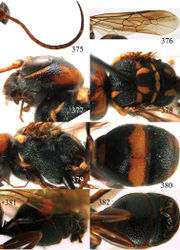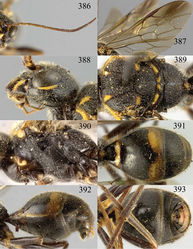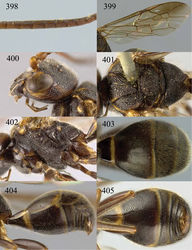Taeniogonalos gestroi
| Notice: | This page is derived from the original publication listed below, whose author(s) should always be credited. Further contributors may edit and improve the content of this page and, consequently, need to be credited as well (see page history). Any assessment of factual correctness requires a careful review of the original article as well as of subsequent contributions.
If you are uncertain whether your planned contribution is correct or not, we suggest that you use the associated discussion page instead of editing the page directly. This page should be cited as follows (rationale):
Citation formats to copy and paste
BibTeX: @article{Chen2014ZooKeys385, RIS/ Endnote: TY - JOUR Wikipedia/ Citizendium: <ref name="Chen2014ZooKeys385">{{Citation See also the citation download page at the journal. |
Ordo: Hymenoptera
Familia: Trigonalyidae
Genus: Taeniogonalos
Name
Taeniogonalos gestroi (Schulz, 1908) comb. n., re-instated – Wikispecies link – Pensoft Profile
- Poecilogonalos thwaitesi var. gestroi Schulz, 1908: 24; Bischoff 1938[1]: 8.
- Poecilogonalos pulchella gestroi; Weinstein and Austin 1991[2]: 423.
- Poecilogonalos thwaitesi thwaitesi; Weinstein and Austin 1991[2]: 424 (p.p.).
- Taeniogonalos thwaitesii; Tsuneki 1991: 51; Carmean and Kimsey 1998[3]: 68 (p.p.; not Westwood 1874[4]).
Additional material
1 + (ZMB), “[China:] Formosa, Taihorin [= Dalin, Chiayi County], V.[19]09, H. Sauter, S.G.”, “pulchella Westw., det. Bischoff”; 1 + (IZCAS) “[China:] Yunnan, Naban River Watershed National Nature Reserve, 22.13059°N, 100.66817°E, 753m, 6.VI.2008, MT, A. Weigel, IOZ(E)1903927”; 1 > (IZCAS) “[China:] Jiangsu, Nanjing, Lingusi, 12.VII.1957, IOZ(E)1495290”; 1 > (IZCAS) “[China:] Guangxi, Pingxiang, 12.IV.1963, Shu-yong Wang, IOZ(E)1495289”; 11 + + 5 > (IZCAS) “[China:] Yunnan, Naban River Watershed National Nature Reserve, 22.13059°N, 100.66817°E, 753m, 6.VI.2008, MT, A. Weigel, IOZ(E)1903925, IOZ(E)1903926; id., but 8.VI.2008, IOZ(E)1910500; id., but 10.VI.2008, IOZ(E)1903929; id, but 16.VI.2009, Ling-zeng Meng, IOZ(E)1903935; id., but, 22.15857°N, 100.66529°E, 709 m, 20.V.2008, IOZ(E)1903928; id., but 26.III.2009, Ling-zeng Meng, IOZ(E)1903928; id., but 18.VIII.2008, IOZ(E) 1903931; id., but 20.X.2008, IOZ(E)1903932; id., but 28.VI.2008, IOZ(E)1903933, IOZ(E)1903934; id., but 6.VI.2008, IOZ(E)1903937; id., but 15.VI.2008, IOZ(E)1903938; id., but 25–26.V.2008, Feng Liu, IOZ(E)1903939; id., but, 22.13091°N, 100.66861°E, 689m, 28.VI.2008, Ling-zeng Meng, IOZ(E)1903935; id., but 14.XII.2007, IOZ(E) 1903940”; 1 + (IZCAS) “[China:] Yunnan, Hekou, Xiaonanxi, 200 m, 9.VI.1956, Ke-ren Huang, IOZ(E)1495286”; 1 + (IZCAS) “[China:] Yunnan, Xishuangbanna, Damenglong, 7.IV.1958, Fu-ji Pu, IOZ(E)1495287”; 3 + + 1 > (IZCAS) “[China:] Yunnan, Jingping, Mengla, 420 m, 19–21. IV.1956, Ke-ren Huang, IOZ(E)1495291, IOZ(E)1495292; id., but 400 m, 28.IV.1956, IOZ(E)1495285; id., but 370 m, 12.IV.1956, IOZ(E)1495288”.
Diagnosis
Supra-antennal elevations 0.1–0.4 times as long as scapus and outer side of elevations oblique (Fig. 419); head posteriorly with extensive yellowish or orange-brown pattern, including a V-shaped yellow or orange pattern behind stemmaticum (Fig. 419); head dorsally often densely reticulate-punctate (Fig. 419); clypeus moderately emarginate medio-ventrally (Fig. 418); middle mesoscutal lobe similar to lateral lobes, black or yellow laterally and black medially (Fig. 423); mesopleuron and metapleuron with extensive yellow pattern; third submarginal cell of fore wing 0.5–0.7 times as long as second submarginal cell (Fig. 421); basal cell often largely and posterior half of first submarginal cells of fore wing more or less darkened, similar to colour of marginal cell (Fig. 421); second sternite of both sexes without medio-apical protuberance (Fig. 427), distinctly convex and no opening between second and following sternites in lateral view (Fig. 426); third sternite of female without apical ledge (Fig. 427). Taeniogonalos gestroi is close to Taeniogonalos formosana (sharing the flattened and smooth metanotum medially, the oblique striae or rugae of the propodeum and the densely and finely rugose lateral lobes of the mesoscutum), but differs by the partly yellow mesopleuron and metapleuron (black in Taeniogonalos formosana; Figs 379, 390, 402), clypeus moderately emarginate medio-ventrally (shallowly emarginate), apex of hypopygium of + yellowish brown (dark brown), second submarginal cell 0.5–0.7 times as long as third submarginal cell (0.7–0.8 times) and the gradually depressed second sternite medio-posteriorly (comparatively steeply depressed medio-posteriorly; Fig. 427).
Description
Redescribed after a female from Naban River Watershed, length of body 8.9 mm (of fore wing 7.2 mm).
Head. Antenna with 24 segments; frons reticulate-punctate (Fig. 418); vertex reticulate-punctate behind stemmaticum and near eyes, becoming spaced punctate (interspaces much wider than width of punctures) posteriorly (Fig. 419); temple largely smooth with sparse fine punctures (Fig. 422); head gradually narrowed behind eyes, eye in dorsal view 0.8 times as long as temple (Fig. 419); occipital carina narrow, non-lamelliform and smooth medio-dorsally (Fig. 419); supra-antennal elevations medium-sized (about 0.2 times as long as scapus) and their outer side oblique (Fig. 419); clypeus moderately concave and thick medio-ventrally.
Mesosoma. Length of mesosoma 1.2 times its height (Fig. 424); mesopleuron densely and coarsely reticulate-rugose anteriorly, densely and finely punctate posteriorly; transverse mesopleural groove narrow, shallow and weakly crenulate; notauli narrow, deep and weakly crenulate; middle lobe of mesoscutum reticulate-rugose anteriorly, transversely rugose posteriorly, lateral lobes reticulate-rugose (Fig. 423); scutellar sulcus narrow but complete, weakly crenulate; scutellum densely and finely reticulate-rugose, rather flat and anteriorly near level of level of mesoscutum; metanotum medially slightly convex, not protruding and finely rugose (Fig. 423); propodeum densely and coarsely reticulate-rugose (Fig. 423); posterior propodeal carina thick lamelliform and strongly arched, foramen medially 0.5 times higher than wide basally.
Wings. Fore wing: length of vein 1-M 1.4 times as long as vein 1-SR (Fig. 421).
Metasoma. First tergite 0.6 times as long as apically wide, smooth and with shallow elliptical depression medially (Fig. 425); second–sixth tergites densely reticulate-punctate; sternites densely punctate; second sternite distinctly convex in lateral view, without medio-apical protuberance (Fig. 427); third sternite about 0.2 times as long as second sternite (Fig. 427); hypopygium triangular in ventral view (Fig. 427).
Colour. Yellow with black pattern; frons largely yellow, area above and between supra-antennal elevations largely black but with a heart-shaped yellow spot below anterior ocellus, black marks medio-ventrally extending to base of clypeus; clypeus yellow with ventral margin dark brown; mandible yellow with teeth and latero-ventral margin black; vertex largely black with a V-shaped yellow patch posteriorly and postero-lateral area above occipital carina yellow; upper temple yellow and lower margin black; mesosoma laterally black with following yellow markings: broad oblique stripe on propleuron, stripe on upper pronotum and lower pronotum, broad oblique but medially interrupted stripe on mesopleuron and metapleuron; mesosoma dorsally black with following yellow markings: antero-lateral stripes on middle lobe of mesoscutum, axilla, antero-lateral half, metanotum, broad longitudinal lateral stripes on propodeum; metasoma black with following yellow markings: broad patch on posterior margin of first tergite and anterior margin of second tergite, narrow continuous stripe on posterior an lateral margin of second tergite, postero-lateral broad patches on fourth to sixth tergites, posterior half of first sternite, rather broad stripe on posterior margin of second sternite; palpi dark brown; antenna dark brown with first five segments darker; coxae dorsally, trochanters and trochantelli, base and apex of femora and base of tarsi yellow, remainder of legs dark brown to black; pterostigma dark brown, marginal cell more or less dark brown, remainder of wing membrane subhyaline.
Variation. Length of body 5.5–9.3 mm, of fore wing 4.2–8.1 mm; length of vein 1-M of fore wing 1.2–1.4 times as long as vein 1-SR.
Male. Length of body 7.4–9.1 mm, of fore wing 5.8–6.9 mm; antenna with 24 segments, tyloids linear, 0.8 times as long as segment on 10th–16th segments and 0.5 times as long as segment on 17th segment; genitalia internal.
Biology
Hyperparasitoid of Ichneumonidae in Pyralid caterpillars (Carmean and Kimsey 1998[3]; as Taeniogonalos thwaitesii).
Distribution
China (Jiangsu, Taiwan, Hainan, Yunnan); India (Sikkim); Sri Lanka; Thailand (Thaleban N.P., 200 m); Laos; Papua New Guinea; Myanmar (syntype); Malaysia; Indonesia (Sumatra, syntype).
Notes
As pointed out by Schulz (1908)[5] specimens from Indonesia and Myanmar differ from both examined female syntypes of Taeniogonalos thwaitesii (Westwood, 1874) from Sri Lanka. He created a new name for the specimens from Indonesia and Myanmar: Poecilogonalos pulchella var. gestroi. After examination of a type of Taeniogonalos thwaitesii, Dr D. Smith (in litt.) kindly informed one of us (CvA) that Taeniogonalos thwaitesii (auctt.) from North India up to China is indeed a species different from the typical Taeniogonalos thwaitesii from Sri Lanka and possibly South India. Therefore, we use the first available name for this species, Taeniogonalos gestroi (Schulz, 1908) which is a new combination.
Taxon Treatment
- Chen, H; van Achterberg, C; He, J; Xu, Z; 2014: A revision of the Chinese Trigonalyidae (Hymenoptera, Trigonalyoidea) ZooKeys, 385: 1-207. doi
Other References
- ↑ Bischoff H (1938) Trigonaloidae. Hymenopterorum Catalogus 5: 1-18.
- ↑ 2.0 2.1 Weinstein P, Austin A (1991) The host relationships of trigonalyid wasps (Hymenoptera: Trigonalyidae), with a review of their biology and catalogue to world species. Journal of Natural History 25(2): 399–433. doi: 10.1080/00222939100770281
- ↑ 3.0 3.1 Carmean D, Kimsey L (1998) Phylogenetic revision of the parasitoid wasp family Trigonalidae (Hymenoptera). Systematic Entomology 23: 35–76. doi: 10.1046/j.1365-3113.1998.00042.x
- ↑ Westwood J (1874) Trigonalidae. Thesaurus Entomologicus Oxoniensis 124. Clarendon Press, Oxford.
- ↑ Schulz W (1908) Die Trigonaloiden des Genueser Naturhistorischen Museums. Annali del Museo Civico di Storia Naturale di Genova Ser. 3 4(44): 23–37.
Images
|





